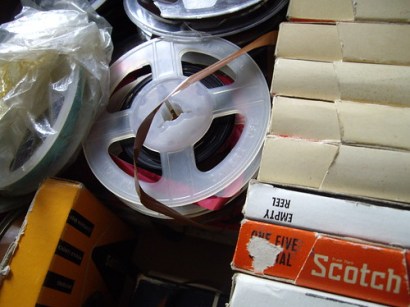The Domestic Soundscape making, listening, thinkingfelicityford@outlook.com
Mixtapes #2
At the weekend I was lucky enough to visit with Mark Vernon who is an artist living in Glasgow and producing a lot of interesting work.

Mark Vernon’s tapes.
Some of the main influences on Mark Vernon’s practise are old, found cassette tapes. For some time now Vernon has made a point of seeking out cassettes at junk shops, fleamarkets and second hand stores. Listening to a box of reels purchased at a fleamarket led him to the discovery of the now defunct Derby Tape Club, which in turn led him to other tape club archives and eventually to various projects and installations that draw on that material. On the basis of his growing collection and knowledge of amateur tape recordings, he produced a radio show for Radio 4 and a series of shows for resonance FM.
The Derby Tape Club – from what I can gather – was a group of enthusiastic sound recordists, active between the 1960s and the 1980s, who had large reel-to-reel tape decks and an enthusiasm for making sound recordings. The group met to share tips, experiences, and equipment, and members of the Derby Tape Club would lug their machines around the country in pursuit of historic moments, live concerts, performances, plays and other audible material, to record. Members of The Derby Tape Club also sent letters to relatives and to each other via the medium of tape, informally recorded at dining room tables or at club meetings. Many such recordings have been lost since recipients would listen to such a letter and then immediately record a response over it, and then send it back. Tapes travelled all over the world in this way I gather, and we listened to some amazing correspondence between one member of The Derby Tape Club and his brother, who was a military man stationed in Germany at that time.
The sense of people familiarising themselves with the recording technology is present in many of the recordings we listened to, as are the physical limitations of the medium. Sections recorded backwards or at an incorrect speed reflect the relative difficulty of using reel-to-reel players when compared – for example – to today’s iPods. A sense of wonder at the ability to record things and reproduce such things as voices, theatre performances, conversations and music is also present in many of the tapes. On this page of Mark’s website there is a link to a few sound clips including one where ‘electronic music’ is made (Mark thinks it’s a spoof) in a kind of craft/DIY way, which is incredibly funny, playful and exuberant. For me, the physicality of the tape medium itself – the clonky, noisy, easy-to-misuse technology of old reel-to-reel players – is definitely something that remained in a reduced way in the smaller cassette tapes which I had, as a child, and which are so nostalgic to me now. And the tapes Mark Vernon has collected reflect to my mind an irreplaceable era in which sound recording was still a novel activity. The sense of messy life being imprinted all over these tapes now – the sense of incomplete history, approximate documentary and patchy coverage – lends the whole collection a very warm and humanistic quality, making them the sort of aural equivalent of old envelopes full of photographs that nobody remembers taking.
How the tapes were used – to transport events from one place to another, to provide entertainment, to preserve specific moments in time – also strikes me as a very domestic and unselfconscious employment of sound-recording technology. Here is the sports day at school. Here is the brass band playing. Here is a news article that I read today. Etc.
So we had an interesting time discussing the qualities of these old tapes, and talking about various ideas relating to how we collect and record sounds, how we listen to sounds, how we use recording technology, and the kinds of communities and activities that gather around sound recording.

By way of synthesising or exploring some of the ideas I’ve been having about the materiality of tape and its relationship to domestic space or domesticity, I present this cross-stitch piece.

This was originally going to be one of my pieces in Love is Awesome, but it has ended up taking on an independant post-exhibition life as one of Felix’s explorations in the imaginative and associative qualities of sounds and how we feel about them. This is mostly because I didn’t finish it in time for the show.
I love the slippage between mediums here; the idea of ‘making a mixtape’ in an unconventional sense, and the opportunity to hone my dreadful cross-stitch skills on something that isn’t so tired already.
Thank you everybody so much for your comments on my last mixtape post; I have emailed you all re: organising awesome mixtape swap.

Pingback: The Domestic Soundscape » Blog Archive » Mark Vernon & Pause Buttons